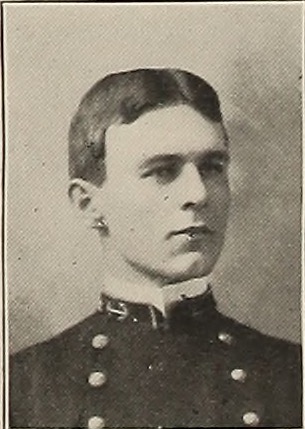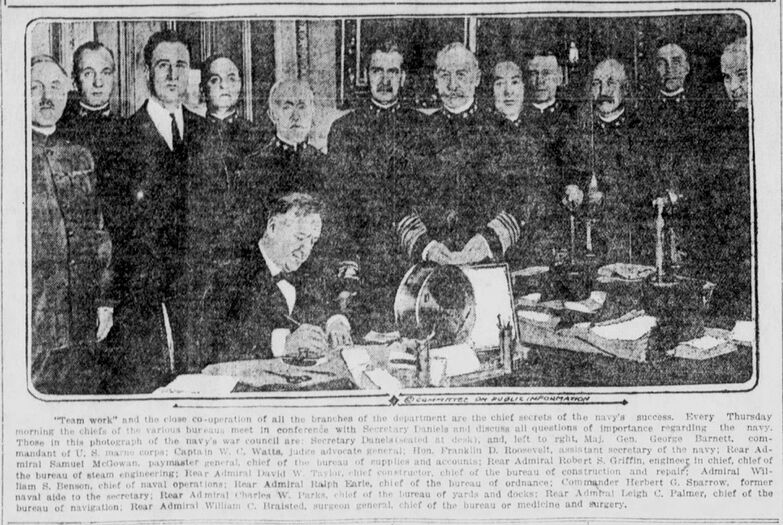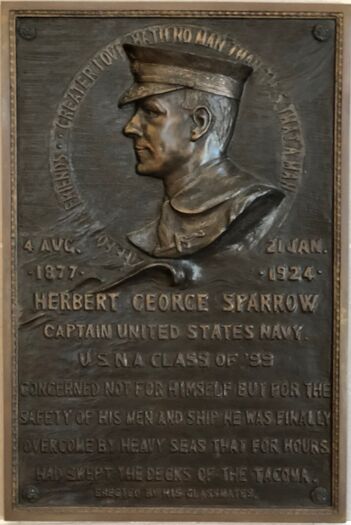HERBERT G. SPARROW, CAPT, USN
Herbert Sparrow '99
Herbert George Sparrow was admitted to the Naval Academy from Ohio on September 6, 1895.
Lucky Bag
From the 1899 Lucky Bag:

Sparrow, Herbert George
" ."
Y. M. C. A. Star (4), (3), (2). Second Class Buzzard (2). Four Stripes (2').
George was a Cadet Lieutenant Commander, the highest rank at the Naval Academy. He was also listed as a "veteran," having served aboard USS Marblehead.
Loss
Herbert was lost on January 21, 1924 when he drowned while attempting to free his command, USS Tacoma (CL 20), from the reef upon which she was grounded.
Other Information
From researcher Kathy Franz:
Born in Cleveland, Herbert was appointed to the Naval Academy by Senator Theodore E. Burton.
During the Spanish American war, he served on the Marblehead and saw fighting under Bowman H. McCalla (Class of 1865.)
Herbert stood No. 1 in his class at the Naval Academy. The last year, he had no demerits. After graduation, he was assigned to the cruiser Chicago.
In June 1900, he was on USS Vixen in Port Padre, Cuba.
On June, 13, 1908, Herbert sailed on the S. S. Empress of India from Hong Kong to Victoria, British Columbia, Canada. He was 5' 10” tall with black hair and blue eyes.
On November 16, 1909, he married Louise W. Kidder in Boston. Soon after he was ordered to the Pacific for three years. His bride refused to remain at home and left before him and met him at each port where his vessel stopped. Their son Herbert was born in Boston on November 24, 1910.
In September 1914, Herbert was on a naval court of inquiry commission of radio experts to decide the responsibility for the disabling of the Tuckerton transatlantic wireless station. A burned-out generator put the tower out of commission. Others on the commission were: Lieutenant Commander Arthur J. Hepburn (Class of 1897), Lieutenant Walter B. Woodson ('05), and Lieutenant Clyde S. McDonald.
In February 1919, Herbert was on the cruiser Chicago at Thompkinsville, Staten Island. He requested the State Department give his wife a passport. Her passport included their son for visits to Rio De Janeiro, Buenos Aires, Montevideo, and other South American ports where the Chicago was going.
In April 1919, Herbert was detached from the cruiser Chicago and assigned to the War College.
From 1920 to 1922, the family lived in Rio de Janeiro where Herbert was naval attaché at the American Embassy. In November 1922, he and his family sailed from Rio de Janeiro to New York City.
In September 1923, Herbert's wife and son had gone to France and Switzerland for one year for their son's education. They were called back to the United States when Herbert died.
Louise became a noted author, sculptor, artist, and poet. As a child, her father hosted many famous people in their home. She met Mark Twain and Julia Ward Howe, the author of the “Battle Hymn of the Republic” who was “a dumpy little old lady who held every one spellbound by her grace and charm.”
Her book “The Last Cruise” is about her life with Herbert and his death. She made his memorial plaque which is in Bancroft Hall; it was unveiled in May 1925 by their son Herbert. In 1929 she made a bust of Senator Theodore E. Burton. In 1930 her bust of Col. Archibald Gracie, IV, hero of the Titanic disaster, was unveiled in the National Gallery of Art in Washington, D. C.
Herbert's father Joseph, who was born in Ireland, was a dealer in boots and shoes. His mother was Amelia.
Herbert's brother William Hutchington Sparrow became an electrical engineer and later was a hotel manager in Hattiesburg, Mississippi. Their sister Cassie Ann became Mrs. Gustave A. Sohl of Cleveland, Ohio.
Herbert's mother and brother lived together for many years. In 1910 they were in Denver, Colorado, and by 1920 they moved to Hattiesburg, Mississippi. In 1935 his mother moved back to her hometown in Guernsey Island, England. She returned to Hattiesburg, and an article in the newspaper in November 1941, told of her writing her sister Selina Best in Ruettes Brayes, Guernsey Island, via the Red Cross. In February 1944, she was hit by a car crossing the street but was only slightly hurt. She moved back to Cleveland and died in October 1948.
He is buried in Arlington National Cemetery; he was survived by his wife and son, who later graduated the US Military Academy and retired as a Major General in the Army.
Photographs
Herbert pictured on the first page of his wife's book, "The Last Cruise"
Remembrances
From "The Last Cruise":
EXTRACT FROM PROCEEDINGS COURT OF INQUIRY
Captain Sparrow had a fine mind, cultivated to a high degree. He was energetic, painstaking and forceful. Every duty during his twenty-eight years of service has been performed with zeal, intelligence and marked success. He had earned and received the enthusiastic praise of his superiors. With such a record and with the finer qualities on which it was based, his future was one of great promise. By one mistake he lost his ship and his life. He met both catastrophes with conspicuous courage. To the last the spirit of the true officer showed forth—his one concern being not for himself but for the ultimate safety of his ship and his men. His fate is, in the opinion of the court, one of the most poignant tragedies in the history of the Navy.
At the moment of his greatest misfortune he rose to his greatest stature. Captain John W. Greenslade, USN '99
Final Letter
Herbert's final letter to his wife and son:
U.S.S. Richmond
off Vera Cruz Mexico.
19 January 1924.Darling Girl,
Am writing aboard the Richmond which came here today. She goes up to Tampico tonight, whence mail can be sent. The revolution here has prevented all mail in or out for two months.The Richmond leaves here tonight taking four Tacoma officers and 231 men. Two officers and twenty men go to navy tugs and nine officers and fifty-two men remain on the Tacoma for salvage work.
Tomorrow the salvage crew will arrive and we shall start work on the Tacoma. Pray for good weather dear. If it holds good I am sure we can float the ship. If it is bad she will break up. It will be much to my help if we float her.
No mail can come here or leave so I can't hear from you nor send you anything, but don't worry, all will be well. I'll radio you if any change occurs.
I may be here one or more months on salvage work so you remain in France, just go ahead as if nothing had happened.
I shall have hard work happily and that will keep my mind off my troubles. We'll get along all right on the Tacoma. The oil lights at night are dismal, but we play Mah Jong and time passes quickly. We get tired so we sleep well.
I haven't time to write a long letter, dear, so I'll close now. Keep well, strong and happy, darling sweetheart. If you and Herbert stand by me as I know you will, we'll show them yet.
Saturday 9 P. M . - Just back from aboard the Richmond, dear, I have been there all day as Adm. Magruder's guest. He was very sympathetic, also Capt. Boyd. Both, of course realize that I am in for a pretty hard time. The wrecking of a ship is serious.
But I was able to be just as cheery today as I have ever been. You would be proud of me, sweetheart, if you saw me, for I have adopted the Salvation Army motto—"I may be down, but I'm not out."
The Richmond will leave tonight for Tampico whence mail goes daily to the States, so I hope you will have this in two weeks. I wish I could hear from you but that is impossible.
Now, dear, I must write Mother a letter, then turn in. If we can only have a few days' smooth weather I know we'll float the ship.
Goodnight, dear sweetheart. The knowledge of your love and Herbert's is my strong bulwark in trouble…
The "Register of Commissioned and Warrant Officers of the United States Navy and Marine Corps" was published annually from 1815 through at least the 1970s; it provided rank, command or station, and occasionally billet until the beginning of World War II when command/station was no longer included. Scanned copies were reviewed and data entered from the mid-1840s through 1922, when more-frequent Navy Directories were available.
The Navy Directory was a publication that provided information on the command, billet, and rank of every active and retired naval officer. Single editions have been found online from January 1915 and March 1918, and then from three to six editions per year from 1923 through 1940; the final edition is from April 1941.
The entries in both series of documents are sometimes cryptic and confusing. They are often inconsistent, even within an edition, with the name of commands; this is especially true for aviation squadrons in the 1920s and early 1930s.
Alumni listed at the same command may or may not have had significant interactions; they could have shared a stateroom or workspace, stood many hours of watch together… or, especially at the larger commands, they might not have known each other at all. The information provides the opportunity to draw connections that are otherwise invisible, though, and gives a fuller view of the professional experiences of these alumni in Memorial Hall.
January 1900
January 1901
January 1902
January 1903
January 1904
January 1905
July 1906
July 1907
January 1908
January 1909
January 1910
January 1911
January 1912
January 1914
January 1915
January 1916
January 1917
March 1918
January 1919
January 1920
January 1921
January 1922
May 1923
July 1923
September 1923
November 1923
January 1924
Memorial
Herbert is one of 4 members of the Class of 1899 on Virtual Memorial Hall.

The "category" links below lead to lists of related Honorees; use them to explore further the service and sacrifice of alumni in Memorial Hall.




